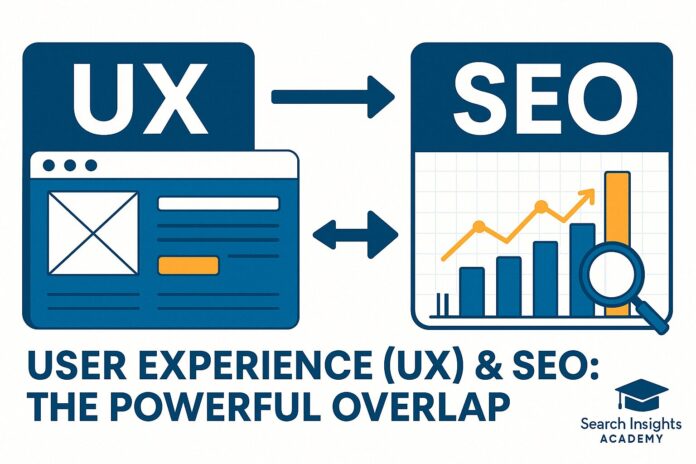Have you ever landed on a website only to leave immediately because it took forever to load or was impossible to navigate? This experience perfectly illustrates why user experience (UX) is now inseparable from successful SEO. Today’s search engines don’t just analyze keywords—they evaluate how real people interact with your website.
This comprehensive guide explores the critical intersection of UX and SEO, revealing how design, navigation, content presentation, and technical performance collectively influence your search rankings. You’ll discover practical strategies for improving both user satisfaction and search visibility simultaneously, including insights on Core Web Vitals, site architecture, and content optimization techniques.
By understanding this powerful relationship, you’ll be equipped to create websites that not only rank well but genuinely serve your visitors’ needs—creating a virtuous cycle of improved engagement, higher rankings, and business growth.
What Is User Experience SEO?
User experience SEO represents the strategic integration of design, content, and technical practices that simultaneously satisfy both human visitors and search engine algorithms. Rather than treating these as separate concerns, modern digital marketing recognizes them as complementary forces that work best when aligned.
Google’s algorithms have evolved significantly, now placing considerable weight on how users interact with websites after clicking through from search results. These behavioral signals include:
- Time spent on page
- Number of pages visited per session
- Return visit frequency
- Bounce rates and exit patterns
At its core, effective UX-SEO integration means delivering a seamless journey characterized by:
- Fast-loading pages that respect users’ time
- Intuitive navigation that makes finding information effortless
- High-quality, readable content that answers questions clearly
- Mobile-responsive design that works across all devices
The relationship works both ways. Even perfectly optimized content will underperform if visitors encounter slow load times or confusing layouts. Conversely, a visually stunning site with poor keyword implementation might never attract organic traffic in the first place.
This balanced approach helps drive qualified traffic from search engines while ensuring visitors remain engaged once they arrive—creating a positive feedback loop that search engines increasingly reward.
Understanding the Impact of UX on Search Rankings
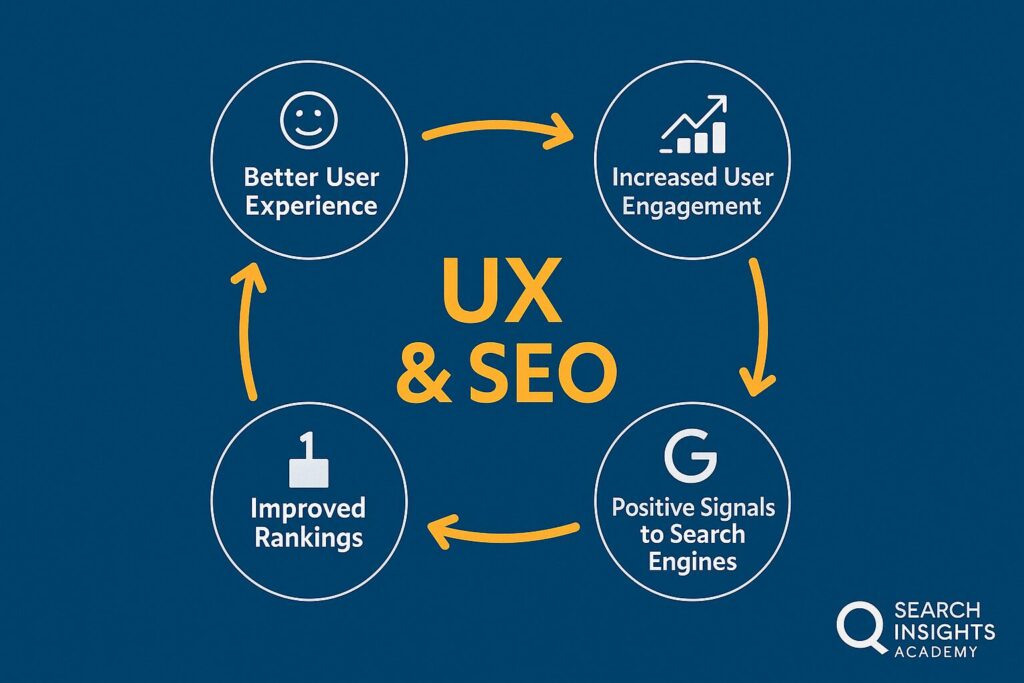
Google has made user experience a central ranking consideration, particularly with the introduction of Core Web Vitals as confirmed ranking factors. These metrics evaluate three critical aspects of user experience:
- Largest Contentful Paint (LCP): Measures loading performance—how quickly the main content appears
- First Input Delay (FID): Measures interactivity—how responsive your site is when users try to interact with it
- Cumulative Layout Shift (CLS): Measures visual stability—whether elements unexpectedly shift while the page loads
Beyond these technical measurements, search engines closely analyze user behavior signals. When visitors quickly return to search results after visiting your site (known as “pogo-sticking”), it suggests your content didn’t meet their needs—a negative signal for rankings. Conversely, when users engage deeply with your content, spending significant time exploring multiple pages, search engines interpret this as a positive quality indicator.
The relationship between UX and SEO creates a virtuous cycle:
- Better user experience leads to increased engagement
- Increased engagement sends positive signals to search engines
- Search engines reward the site with improved rankings
- Improved rankings drive more targeted traffic
- The cycle continues, amplifying results over time
This interconnection explains why technical SEO and UX optimization should be coordinated rather than treated as separate initiatives. Each enhancement in user experience potentially translates to ranking improvements, creating compounding returns on your investment.
The Foundations of UI/UX SEO
Defining UI/UX SEO: Where Design Meets Search
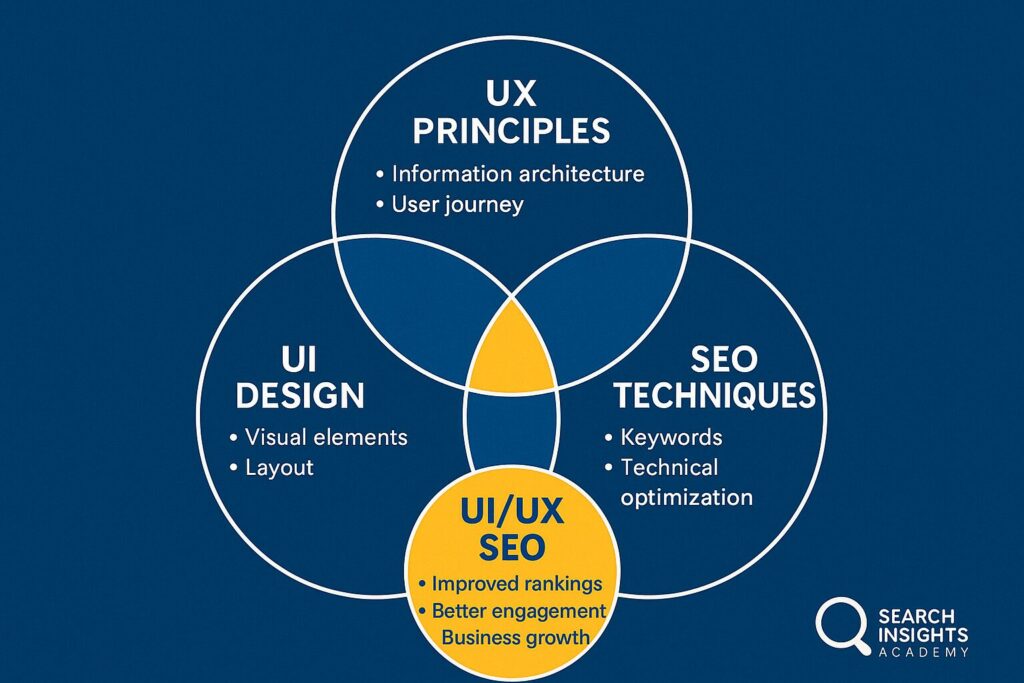
UI/UX SEO represents the strategic integration of user interface design, user experience principles, and search engine optimization techniques. This approach recognizes that these disciplines don’t merely coexist—they actively strengthen each other when properly aligned.
User Interface (UI) encompasses the visual and interactive elements visitors encounter:
- Buttons and navigation menus
- Color schemes and typography
- Layout structures and visual hierarchy
User Experience (UX) covers the broader journey and emotional response:
- Information architecture and content flow
- Ease of completing desired actions
- Overall satisfaction with the interaction
When these design elements work in concert with SEO best practices, websites achieve what neither discipline could accomplish alone:
- Structured data helps search engines understand content while enhancing user interactions through rich results
- Strategic keyword placement improves rankings while also helping users quickly confirm they’ve found relevant information
- Clear navigation hierarchies improve crawlability for search engines while making content discovery intuitive for visitors
As Google’s own documentation states, “Creating helpful, reliable, people-first content is key to success.” This perfectly captures the UI/UX SEO philosophy—optimizing primarily for humans while ensuring search engines can effectively interpret and index your content.
Common Misconceptions About SEO and User Experience
Several persistent myths continue to create false dichotomies between SEO and UX practices:
Myth 1: SEO requires keyword stuffing that makes content unreadable Reality: Modern SEO prioritizes natural language, topical relevance, and comprehensive answers to user questions. Keyword stuffing actively harms both rankings and user experience.
Myth 2: Design creativity must be sacrificed for SEO Reality: Creative design that enhances clarity, guides users to important content, and works across devices actually supports SEO goals. The constraint isn’t creativity but performance—ensuring design elements don’t compromise load times or accessibility.
Myth 3: Technical SEO and UX are separate concerns Reality: Technical SEO factors like site speed, mobile-friendliness, and secure connections (HTTPS) are fundamental UX considerations that directly impact visitor satisfaction and behavior metrics.
Myth 4: Rankings come from optimization, not user behavior Reality: Search engines increasingly use behavior signals including bounce rates, time on page, and interaction patterns to evaluate content quality and relevance.
Understanding these connections allows marketers to pursue integrated strategies that serve both users and search algorithms, rather than treating them as competing priorities.
Why Does UX Affect SEO?
UX directly influences SEO through several key mechanisms:
1. Engagement Metrics as Quality Signals When users find a site helpful and engaging, they demonstrate this through measurable behaviors:
- Longer time spent on pages
- Lower bounce rates
- Higher pages-per-session counts
- Increased return visits
Search engines interpret these patterns as indicators of content quality and relevance, potentially boosting rankings for pages that generate positive engagement.
2. Core Web Vitals as Ranking Factors Google explicitly includes user experience metrics in its ranking algorithm, measuring factors like:
- Page loading performance (LCP)
- Interactivity (FID)
- Visual stability (CLS)
Sites that deliver excellent performance on these metrics gain a competitive advantage in search rankings.
3. Mobile Experience Prioritization With mobile-first indexing, Google primarily uses the mobile version of content for indexing and ranking. Sites offering poor mobile experiences face significant ranking disadvantages, regardless of their desktop quality.
4. Accessibility and Crawlability Overlap Many accessibility improvements that benefit users with disabilities—like proper heading structures, descriptive alt text, and keyboard navigation—simultaneously improve search engine crawling and understanding of content.
These connections demonstrate why UX improvements often correlate with ranking improvements—they’re addressing the same fundamental quality indicators that search engines use to evaluate content value.
Key Components of UX That Influence SEO
Page Speed, Mobile Responsiveness, and Core Web Vitals
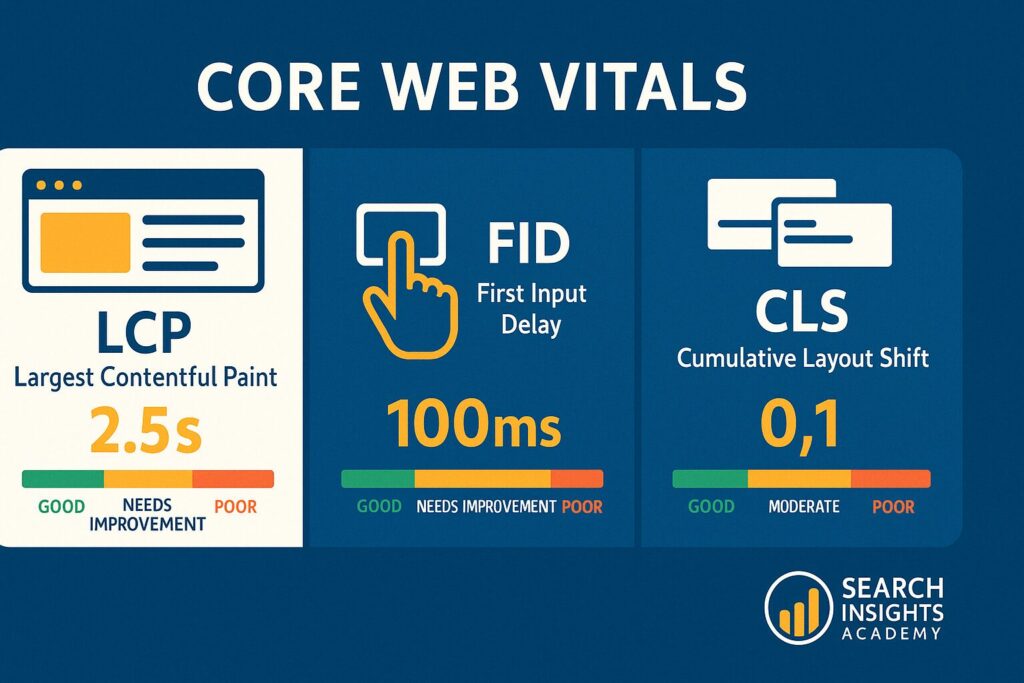
Page speed has emerged as one of the most critical factors at the intersection of UX and SEO, with research showing that bounce probability increases 32% as page load time increases from 1 to 3 seconds.
Core Web Vitals provide specific metrics for evaluating page experience:
- Largest Contentful Paint (LCP) should occur within 2.5 seconds of page load, ensuring users quickly see meaningful content
- First Input Delay (FID) should be less than 100 milliseconds, providing near-immediate response to interactions
- Cumulative Layout Shift (CLS) should maintain a score under 0.1, preventing frustrating visual shifts during loading
Practical techniques to improve these metrics include:
- Implementing proper image optimization with next-gen formats like WebP
- Using responsive images with appropriate
srcsetattributes - Enabling browser caching for returning visitors
- Minifying CSS and JavaScript
- Eliminating render-blocking resources
- Implementing critical CSS for above-the-fold content
- Lazy-loading images and videos below the fold
Mobile responsiveness remains paramount, with Google’s mobile-first indexing approaching universal implementation. Beyond responsive design basics, this includes:
- Touch-friendly navigation with appropriately sized tap targets
- Font sizes that remain readable without zooming
- Forms that function properly on touchscreen devices
- Content that doesn’t require horizontal scrolling
These technical optimizations deliver dual benefits—improving both user satisfaction and search ranking potential simultaneously.
Site Navigation and Architecture for Better User Experience
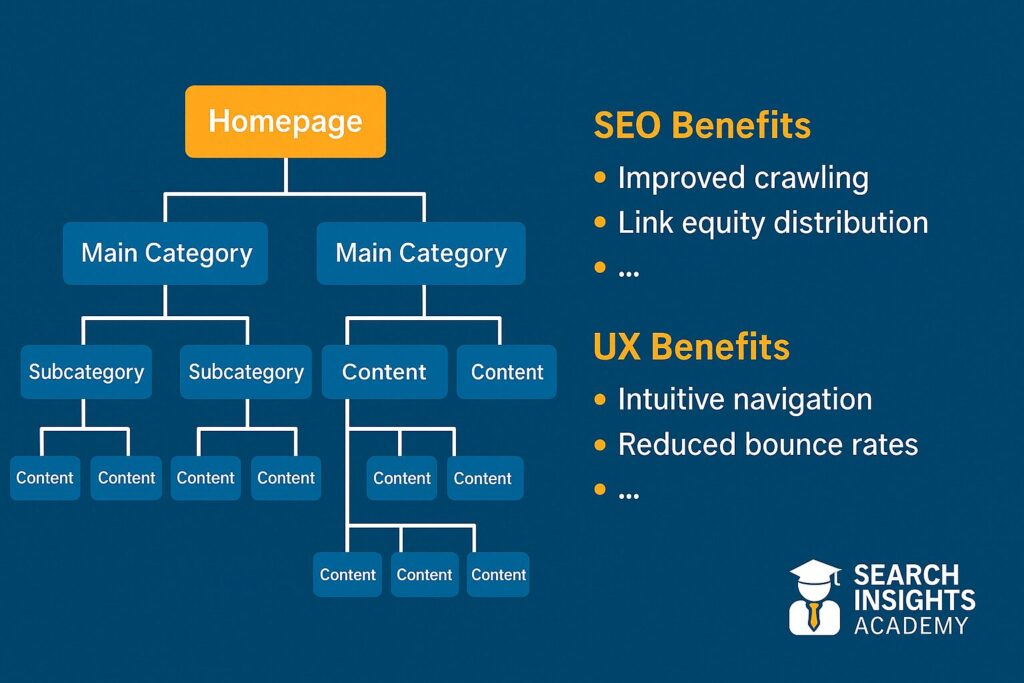
Effective site architecture performs the crucial dual function of helping both users and search engines discover and understand your content. Well-structured websites typically feature:
- Clear hierarchical organization with logical parent-child relationships between pages
- Intuitive main navigation that highlights key content categories
- Breadcrumb navigation that reinforces site structure and aids orientation
- Consistent internal linking that creates contextual connections between related content
- Descriptive, keyword-rich anchor text that provides context for linked pages
This thoughtful organization delivers significant SEO advantages:
- Improved crawl efficiency – Search engines can more effectively discover and index content when navigation paths are clear
- Enhanced topical relevance – Content relationships help search engines understand subject matter expertise
- More effective link equity distribution – Strategic internal linking helps important pages receive appropriate ranking priority
- Lower bounce rates – When users can easily find related content, they’re less likely to leave the site
Additionally, logical URL structures that reflect your site hierarchy (e.g., /category/subcategory/topic) provide both users and search engines with meaningful context about content relationships and importance.
For more complex sites, implementing topic clusters and pillar pages creates a content architecture that signals topical authority to search engines while guiding users through comprehensive information resources.
Engaging Content and Readability
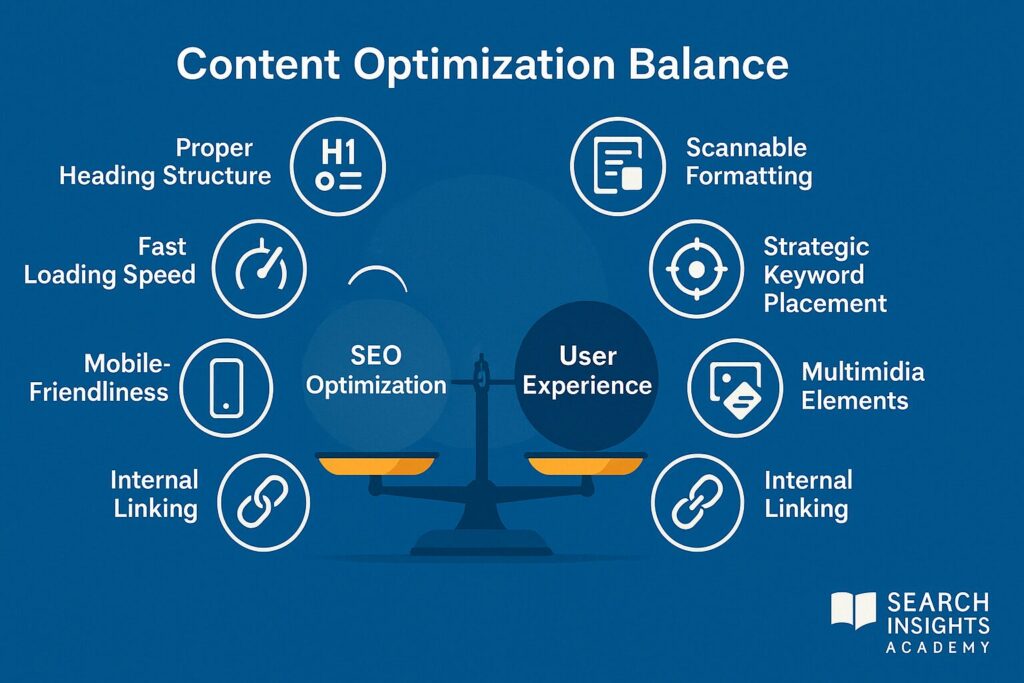
Content serves as the fundamental connection point between SEO and UX—it must simultaneously satisfy search engines and human readers. Effective content optimization balances several key factors:
Readability and Formatting
- Short paragraphs (3-4 sentences maximum)
- Bulleted and numbered lists for scannable information
- Descriptive subheadings that break content into logical sections
- Strategic use of bold text to highlight key points
- Adequate white space to prevent visual overwhelm
Engagement Elements
- Relevant images that clarify or enhance textual content
- Embedded videos for concepts better explained visually
- Interactive elements like calculators or quizzes where appropriate
- Pull quotes or callouts for important statistics or takeaways
Comprehensiveness and Depth
- Thorough coverage of topics that answers the primary user question
- Anticipation of related questions and follow-up needs
- Structured data markup to enhance search appearance with rich results
- Contextual internal links to related content for users seeking additional information
Strategically implementing these elements creates content that not only ranks well but holds attention and provides genuine value, improving crucial engagement metrics like time on page and reducing bounce rates.
As highlighted in content optimization best practices, the goal is creating resources that comprehensively address user needs while remaining accessible and engaging—precisely what both search engines and users reward.
Visual Appeal vs. Functionality: Balancing UI/UX SEO
The relationship between visual design and functional performance requires thoughtful balance. While aesthetic elements contribute significantly to brand perception and user engagement, they must be implemented with performance in mind:
Balancing Design Elements with Performance
- Use SQIP (SVG-based image placeholders) to maintain visual appeal during loading
- Implement proper image compression and modern formats like WebP and AVIF
- Consider the performance impact of web fonts, limiting to 2-3 font families
- Evaluate animation and interactive elements for performance costs versus UX benefits
Achieving Visual Distinction Without Performance Penalties
- Use CSS for visual effects rather than image-based design elements where possible
- Implement a progressive enhancement approach that ensures basic functionality first
- Consider skeleton screens instead of spinners for perceived performance improvement
- Design with performance budgets in mind, allocating resources strategically
The most effective approach treats performance as a design constraint from the beginning—not as an afterthought or technical optimization. This “performance-first” mindset ensures visual elements enhance rather than detract from the overall user experience.
When teams collaborate across disciplines—with designers, developers, and SEO specialists working together from project inception—the result is solutions that effectively balance visual appeal, functionality, and performance requirements.
SEO UX Design: Practical Strategies and Quick Wins
Conducting an SEO UI/UX Audit
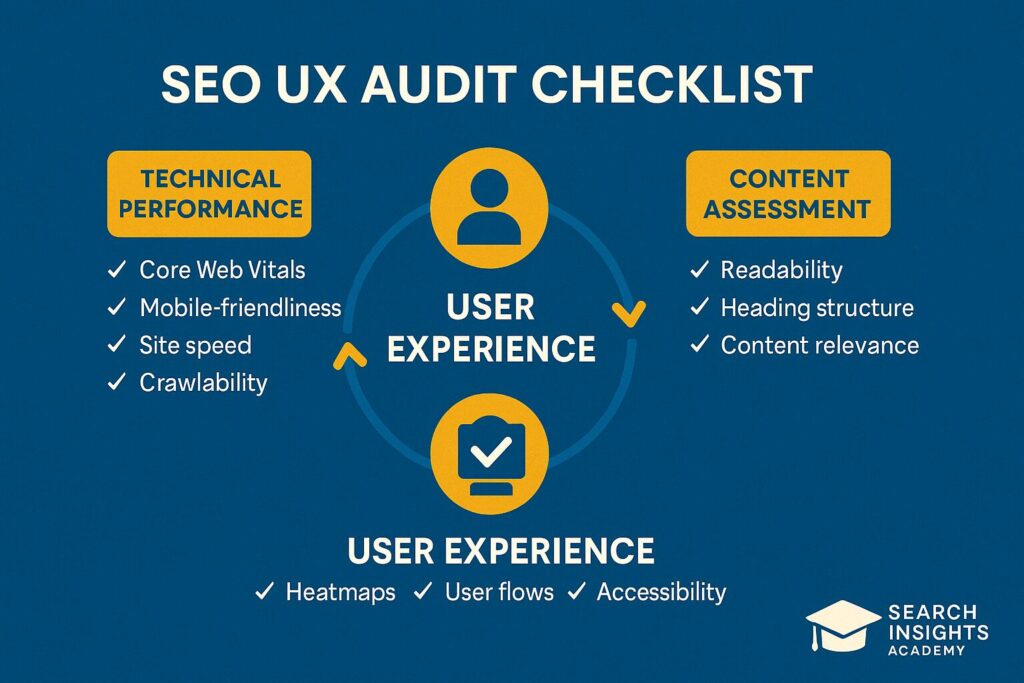
A comprehensive SEO UX audit examines how well your site balances search optimization with user experience. This integrated approach identifies opportunities that benefit both areas:
Technical Performance Assessment
- Test Core Web Vitals using Google’s PageSpeed Insights
- Evaluate mobile responsiveness across device types
- Check for crawl errors and indexation issues in Google Search Console
- Verify proper implementation of structured data
User Experience Evaluation
- Analyze user flow paths in Google Analytics to identify drop-off points
- Conduct heatmap analysis to see where users actually click versus intended pathways
- Review session recordings to identify frustration points or navigation issues
- Implement user testing with specific task completion scenarios
Content and On-Page Assessment
- Evaluate content for readability scores and comprehensiveness
- Check heading structure for logical hierarchy and keyword inclusion
- Review internal linking for contextual relevance and user guidance
- Assess meta title and description effectiveness for both CTR and relevance
By conducting this audit across multiple sample pages representing different content types and functions, you’ll identify patterns of issues affecting both search performance and user satisfaction.
The results typically reveal quick wins—elements that can be immediately improved with relatively low development effort but significant potential impact on both rankings and user metrics.
Minimizing Bounce Rates and Maximizing Dwell Time
High bounce rates and low dwell times often indicate misalignment between user expectations and actual content delivery. Strategic improvements in these areas can dramatically improve both user satisfaction and search rankings:
Content-Focused Strategies
- Ensure your content immediately addresses the core user question in the first paragraph
- Use engaging introductions that confirm users have found what they’re seeking
- Implement comprehensive content that anticipates and answers follow-up questions
- Include visual elements like images, charts, or videos to increase engagement
Navigation and Structure Improvements
- Add contextually relevant internal links to related content
- Implement “You might also be interested in” sections at logical content breaks
- Use anchor links for long-form content to help users navigate to specific sections
- Create clear, visible pathways to logical next steps based on user intent
Technical Enhancements
- Improve page loading speed, particularly for mobile users
- Eliminate intrusive interstitials that disrupt the user experience
- Fix layout shifts that may cause accidental clicks or navigation errors
- Ensure consistent rendering across different browsers and devices
These improvements directly address common reasons users abandon pages—slow loading, difficulty finding relevant information, and confusing navigation patterns. By solving these problems, you simultaneously improve SEO signals and user satisfaction.
Using Readable Formatting and Intuitive Layouts
The presentation of your content significantly impacts both readability for users and interpretability for search engines. Strategic formatting improvements include:
Text Formatting Best Practices
- Use descriptive H2 and H3 headings that incorporate relevant keywords naturally
- Keep paragraphs short (3-4 sentences maximum) to improve scannability
- Implement bulleted and numbered lists for sequential or grouped information
- Use strategic bold text to highlight key points or concepts
- Maintain adequate white space to prevent visual overwhelm
Layout Optimization
- Place the most important information “above the fold” when possible
- Use a consistent, predictable layout structure across similar content types
- Implement clear visual hierarchy that guides readers through content
- Create distinct visual separation between different content sections
- Ensure adequate color contrast for text readability
Mobile-Specific Considerations
- Prioritize critical content for mobile displays
- Ensure touch targets are properly sized (minimum 44×44 pixels)
- Verify form fields are easily accessible and completable on mobile devices
- Test readability of text at mobile sizes without requiring zoom
These formatting and layout improvements facilitate both human comprehension and search engine understanding of your content structure and relevance. When content is well-organized with clear heading hierarchies, both users and search algorithms can more easily determine its value and relevance.
Overcoming Common Pain Points in SEO & UX
Low-Hanging Fruit for UI/UX SEO Improvements
Some of the most impactful UX-SEO improvements require relatively minimal implementation effort:
Quick Technical Wins
- Compress and properly size images using tools like TinyPNG or Squoosh
- Implement browser caching through proper HTTP headers
- Enable text compression (GZIP or Brotli) on your server
- Fix broken links and redirect chains identified in crawler reports
- Implement lazy loading for images and videos below the fold
Content Optimization Quick Fixes
- Update title tags and meta descriptions for high-traffic pages to improve CTR
- Add descriptive alt text to all images
- Fix duplicate content issues through canonical tags
- Update outdated statistics or information in evergreen content
- Add schema markup to eligible content for rich results potential
Navigation and UX Improvements
- Simplify primary navigation to focus on core categories
- Add breadcrumb navigation for improved wayfinding
- Update internal links in top-performing content to guide users to related resources
- Improve mobile menu usability with larger touch targets and clearer organization
These relatively straightforward optimizations often yield disproportionate results, particularly when applied to high-traffic pages or common user pathways. By prioritizing improvements based on page importance and current performance metrics, you can maximize the impact of limited development resources.
Avoiding Keyword Stuffing While Enhancing User Experience
Modern SEO requires a sophisticated approach to keyword integration that prioritizes natural language and user experience:
Strategic Keyword Integration
- Focus on semantic relevance rather than keyword density
- Use related terms, synonyms, and natural language variations
- Place important keywords in strategic locations (titles, headings, first paragraph)
- Ensure every keyword usage serves the reader’s understanding
Content Quality Priorities
- Create comprehensive resources that thoroughly address the user’s query
- Organize content logically with clear section headings
- Include supporting elements (images, videos, tables) that enhance understanding
- Write for humans first, with search optimization as a secondary consideration
Natural Language Processing Considerations
- Consider entities and relationships between concepts, not just keywords
- Use topic clusters to establish subject matter expertise
- Incorporate questions users actually ask about the topic
- Address related concerns and follow-up questions within content
This approach aligns with Google’s increasingly sophisticated natural language processing capabilities, which focus on understanding topics and user intent rather than simple keyword matching. The result is content that both ranks well and genuinely serves user needs—creating positive engagement metrics that further reinforce search performance.
Balancing Design Innovations with Search Optimization
Implementing creative design elements while maintaining strong SEO performance requires thoughtful consideration of performance implications:
Performance-Conscious Design
- Implement new visual elements progressively, testing impact on Core Web Vitals
- Consider adaptive loading that delivers simpler experiences to lower-end devices
- Use performance budgets to maintain discipline in design implementation
- Test innovations with real users before full deployment
SEO-Friendly Implementation Methods
- Ensure JavaScript-dependent features degrade gracefully
- Implement proper pre-rendering or server-side rendering for JavaScript content
- Use the appropriate element types for content (e.g., actual buttons for clickable items)
- Maintain crawlable text even when using innovative presentation methods
Testing and Validation
- Verify search engine rendering matches user experience
- Test new features across multiple devices and connection speeds
- Monitor key performance indicators after implementation
- Be prepared to adjust or remove elements that negatively impact performance
By establishing clear performance criteria and testing methodologies before implementing new design features, teams can innovate while maintaining the technical foundation necessary for strong SEO performance. This balanced approach allows for distinctive, brand-appropriate experiences without sacrificing search visibility.
Core Ranking Factors Influenced by User Experience
Google has increasingly incorporated user experience signals into its ranking algorithm, with several explicit connections:
Page Experience Signals
- Core Web Vitals (LCP, FID, CLS) are confirmed ranking factors
- Mobile-friendliness directly impacts rankings through mobile-first indexing
- Safe browsing factors protect users from deceptive sites
- HTTPS implementation provides security and ranking benefits
- Intrusive interstitial guidelines penalize disruptive advertising
Content Accessibility and Structure
- Proper semantic HTML helps search engines understand content purpose
- Accessible design improves usability for all visitors
- Clear content hierarchy with proper heading structure aids both users and search engines
- Descriptive link text improves navigation for both humans and crawlers
Technical Performance Factors
- Page speed affects both rankings and user engagement metrics
- Rendering efficiency impacts crawl budget allocation
- JavaScript parsing and execution time affects indexability
- Server response time influences crawling frequency and depth
These factors demonstrate Google’s commitment to rewarding sites that prioritize user experience, creating direct ranking incentives for UX improvements beyond their inherent user benefits.
As Google’s documentation states: “Google’s automated systems aim to surface helpful content created for people in search results.” This philosophy increasingly merges UX quality with ranking potential.
User Behavior Signals and How Google Interprets Them
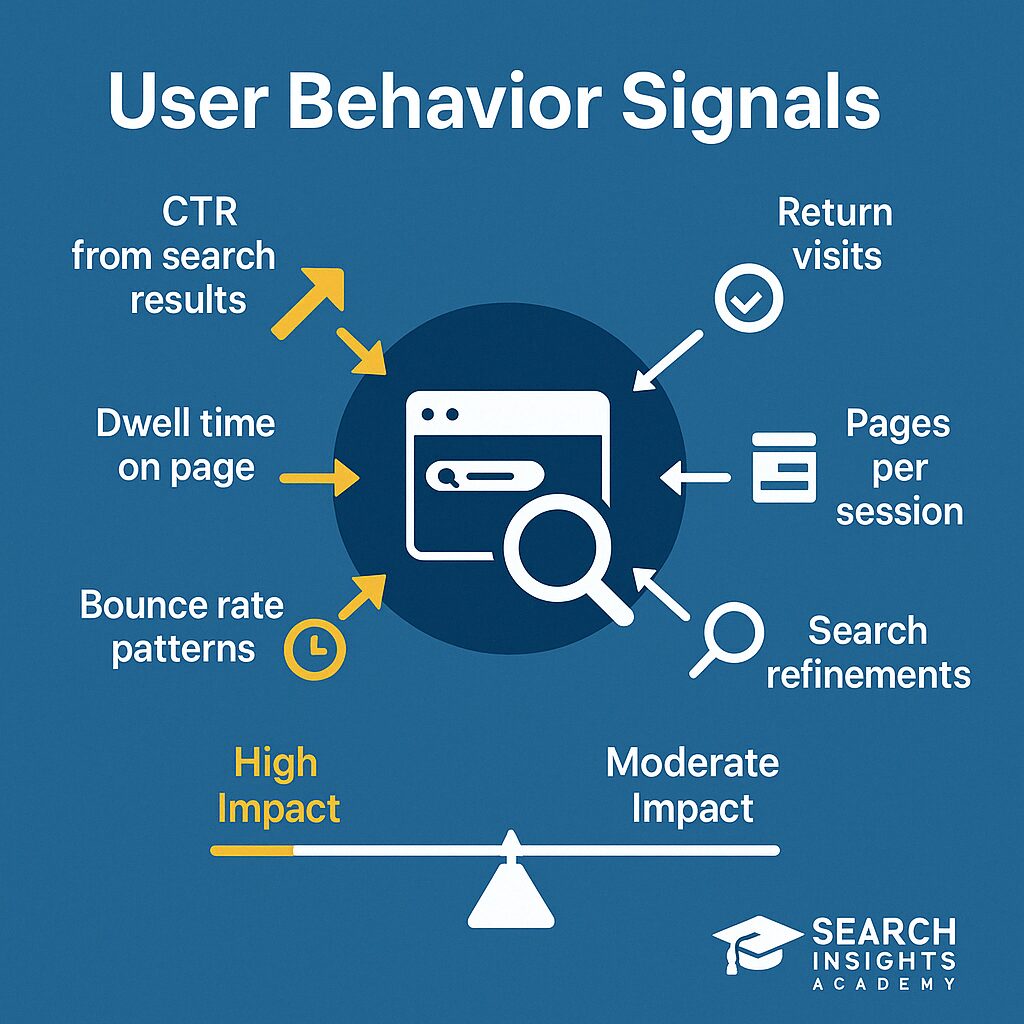
While Google does not explicitly confirm all the user behavior signals in its algorithm, substantial evidence indicates several metrics influence rankings:
Engagement Metrics
- Click-through rate (CTR) from search results may influence ranking adjustments
- Dwell time (how long visitors stay before returning to search results) indicates content relevance
- Bounce rate patterns across large datasets help evaluate content quality
- Pages per session demonstrates content depth and user engagement
Search Pattern Signals
- Pogo-sticking (quickly returning to results and selecting a different listing) suggests poor content match
- Search refinements after visiting a page indicate incomplete information
- Return visits from the same user suggest content value
- Brand searches following general queries indicate authority and trust
Long-term User Behavior
- Bookmark rates and return direct traffic suggest content worth revisiting
- Content sharing signals value to specific audiences
- Time to long click (visits without returning to search) indicates comprehensive answers
Google likely uses these signals as quality feedback mechanisms rather than direct ranking factors—validating algorithmic assessments of content quality and relevance through real user behavior. This approach allows them to continuously improve search quality while making manipulating rankings through artificial behavior patterns extremely difficult.
How to Measure UX and SEO Success Together
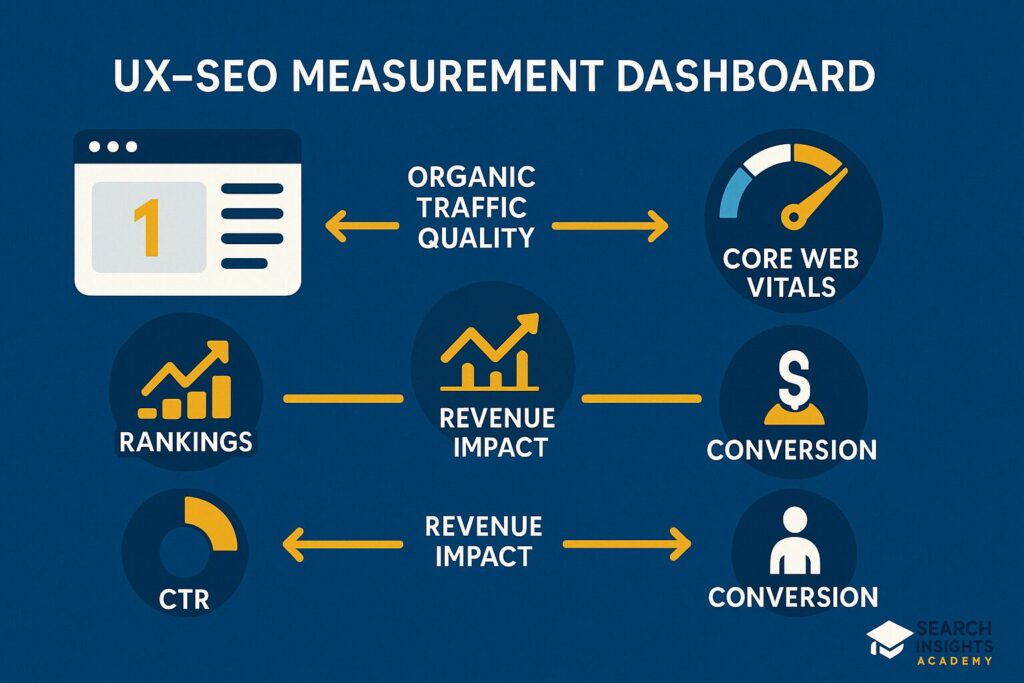
Effective measurement requires tracking both traditional SEO metrics and user experience indicators to understand their interconnection:
Performance Measurement Tools
- Use Google Search Console to track impressions, clicks, position, and CTR
- Monitor Core Web Vitals through PageSpeed Insights and the CrUX report
- Track technical issues through crawl reports from tools like Screaming Frog
- Analyze rendering and JavaScript execution through the URL Inspection tool
User Behavior Analysis
- Set up Google Analytics 4 to track engagement metrics like bounce rate and average session duration
- Implement event tracking for key interactions that indicate content value
- Use enhanced measurement for scrolling depth and outbound clicks
- Create segment comparisons between organic search visitors and other traffic sources
Conversion and Business Impact
- Track micro-conversions that indicate content value (email signups, PDF downloads)
- Monitor assisted conversions from organic content touchpoints
- Analyze the full customer journey from initial organic visit through conversion
- Calculate actual revenue impact from organic traffic improvements
By correlating these different measurement sets, you can identify how UX improvements influence search performance and business outcomes. For example, you might notice that pages with improved Core Web Vitals subsequently experience CTR increases, ranking improvements, and ultimately higher conversion rates.
This holistic measurement approach allows for more accurate ROI calculations on UX investments by capturing their full impact across both search performance and user conversion behavior.
Real-World Example: E-Commerce Success Through UX-SEO Integration
Consider the case of an online retailer specializing in home goods that implemented a comprehensive UX-SEO improvement strategy. Their approach included:
Technical Foundation Improvements
- Optimizing image delivery with WebP format and responsive images
- Implementing server-side rendering for product pages
- Reducing JavaScript execution time for critical interactions
- Adding product schema markup for rich results
User Experience Enhancements
- Redesigning product filters for easier mobile navigation
- Implementing a sticky add-to-cart bar on mobile
- Improving product image galleries with faster loading
- Creating clearer size and specification information
Content Optimization
- Expanding product descriptions with usage scenarios
- Adding FAQ sections to address common questions
- Implementing user-generated content like reviews and photos
- Creating enhanced category pages with buying guides
The results demonstrated clear connections between UX improvements and SEO performance:
- Mobile page speed improved by 45%, with average LCP dropping from 4.2s to 2.3s
- Organic traffic increased 32% within three months of implementation
- Average session duration improved 28% across product pages
- Conversion rate from organic traffic increased 15%
- Featured snippet visibility grew 200% due to FAQ implementation
This case illustrates how integrated UX-SEO strategies deliver compounding benefits—technical improvements enhance user metrics, which reinforce search rankings, which drive more qualified traffic, creating a virtuous cycle of improvement.
Conclusion: Building a Sustainable Strategy for SEO and UX

The integration of UX and SEO represents not just a technical necessity but a fundamental shift in digital marketing approach. By recognizing that search engines increasingly evaluate sites based on user satisfaction signals, marketers can align their optimization efforts with genuine user needs—creating sustainable competitive advantages.
From Quick Wins to Long-Term Gains
Effective UX-SEO integration follows a progressive improvement path:
- Foundation optimization – Address critical technical issues affecting Core Web Vitals and basic usability
- Content refinement – Improve existing content organization, readability, and comprehensiveness
- Experience enhancement – Implement UX improvements that genuinely help users accomplish their goals
- Continuous iteration – Use performance data to identify ongoing opportunities for improvement
This layered approach delivers immediate benefits through quick technical fixes while building toward more substantial advantages through deeper experience improvements. The cumulative effect creates sustainable ranking advantages that become increasingly difficult for competitors to overcome.
Next Steps for Enhancing User Experience and Search Rankings
As you develop your integrated UX-SEO strategy, consider these actionable next steps:
- Conduct a comprehensive audit using tools like PageSpeed Insights, Search Console, and Analytics to identify your biggest opportunities
- Prioritize improvements based on impact potential, focusing first on high-traffic pages with clear performance issues
- Implement a measurement framework that connects UX metrics with SEO performance indicators
- Create cross-functional teams that bring together SEO specialists, designers, developers, and content creators
- Establish regular review cycles to evaluate performance changes and identify new optimization opportunities
By committing to this ongoing process of improvement, you’ll create digital experiences that simultaneously satisfy user needs and search engine quality requirements—positioning your site for sustained organic growth.
Remember that the most powerful SEO strategy is creating genuinely helpful, accessible content delivered through fast, intuitive interfaces. When you prioritize real user needs, search rankings typically follow—creating a virtuous cycle of visibility, engagement, and business growth.

